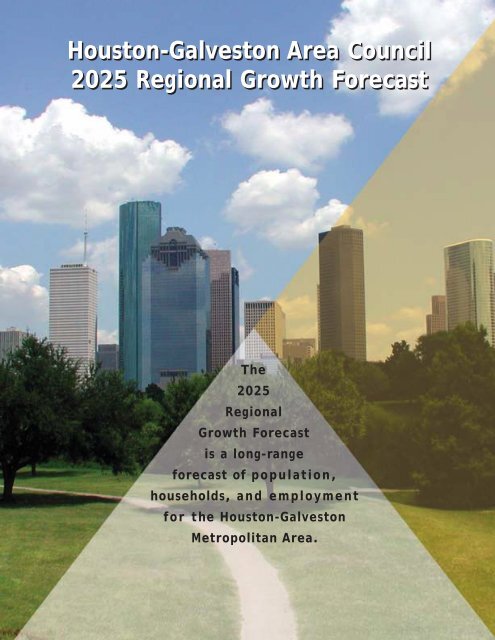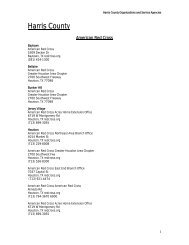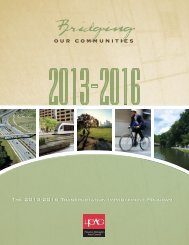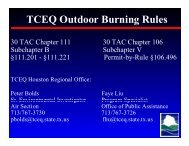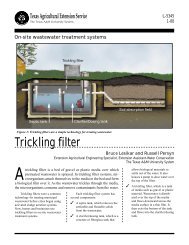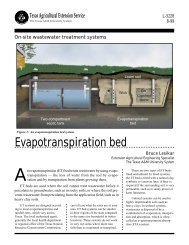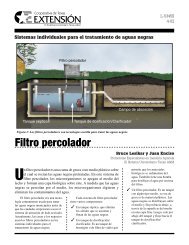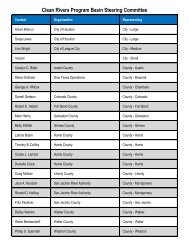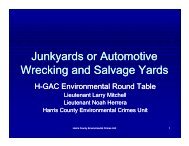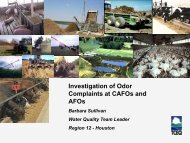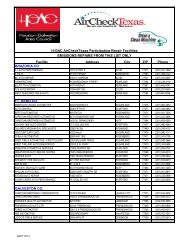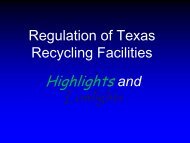Houston-Galveston Area Council 2025 Regional Growth Forecast ...
Houston-Galveston Area Council 2025 Regional Growth Forecast ...
Houston-Galveston Area Council 2025 Regional Growth Forecast ...
You also want an ePaper? Increase the reach of your titles
YUMPU automatically turns print PDFs into web optimized ePapers that Google loves.
<strong>Houston</strong>-<strong>Galveston</strong> <strong>Area</strong> <strong>Council</strong><br />
<strong>2025</strong> <strong>Regional</strong> <strong>Growth</strong> <strong>Forecast</strong><br />
The<br />
<strong>2025</strong><br />
<strong>Regional</strong><br />
<strong>Growth</strong> <strong>Forecast</strong><br />
is a long-range<br />
forecast of population,<br />
households, and employment<br />
for the <strong>Houston</strong>-<strong>Galveston</strong><br />
Metropolitan <strong>Area</strong>.
Board Members of the <strong>Houston</strong>-<strong>Galveston</strong> <strong>Area</strong> <strong>Council</strong> 2003<br />
Chair<br />
Hon. Andy Meyers<br />
Commissioner<br />
Fort Bend County<br />
Chair Elect<br />
Hon. Bill Welch<br />
<strong>Council</strong>man<br />
City of Pasadena<br />
Vice Chair<br />
Hon. Greg Westmoreland<br />
County Judge<br />
Matagorda County<br />
Board Members<br />
Hon. Carolyn C. Bilski<br />
County Judge<br />
Austin County<br />
Hon. James Barnett, Jr.<br />
Mayor<br />
City of Freeport<br />
Home Rule Cities<br />
Hon. Craig Doyal<br />
Commissioner<br />
Montgomery County<br />
Hon. Robert Eckels<br />
County Judge<br />
Harris County<br />
Hon. Chuck Engelken, Jr.<br />
<strong>Council</strong>person<br />
City of La Porte<br />
Hon. Jerry Ericsson<br />
<strong>Council</strong>man<br />
City of Friendswood<br />
Hon. Todd Fontenot<br />
Commissioner<br />
Liberty County<br />
Hon. B. J. Gaines, Jr.<br />
Commissioner<br />
Walker County<br />
Hon. Pat George<br />
<strong>Council</strong> Member<br />
City of Conroe<br />
Hon. Darrell Gertson<br />
Commissioner<br />
Colorado County<br />
Hon. Jack Harris<br />
Commissioner<br />
Brazoria County<br />
Hon. Terry Henley<br />
Alderman<br />
City of Meadows Place<br />
General Law Cities<br />
Hon. Eddie Janek<br />
Commissioner<br />
<strong>Galveston</strong> County<br />
Hon. Joe Jaworski<br />
<strong>Council</strong>man<br />
City of <strong>Galveston</strong><br />
Hon. Hamid Kantara<br />
<strong>Council</strong>man<br />
City of League City<br />
Hon. Bert Keller<br />
<strong>Council</strong> Member<br />
City of <strong>Houston</strong><br />
Hon. Chris King<br />
Commissioner<br />
Wharton County<br />
Hon. Linson Landrum, Jr.<br />
Commissioner<br />
City of Texas City<br />
Hon. El Franco Lee<br />
Commissioner<br />
Harris County<br />
Hon. Denton McDugle<br />
<strong>Council</strong>man<br />
City of Deer Park<br />
Hon. Kay Mudd<br />
<strong>Council</strong>woman<br />
City of Iowa Colony<br />
General Law City<br />
Hon. Donald Murray<br />
<strong>Council</strong>man<br />
City of Baytown<br />
Hon. Kerry Neves<br />
<strong>Council</strong>man<br />
City of Dickinson<br />
Home Rule City<br />
Hon. Owen Ralston<br />
County Judge<br />
Waller County<br />
Hon. Tom Reid<br />
Mayor<br />
City of Pearland<br />
Hon. Eunice Reiter<br />
<strong>Council</strong>woman<br />
City of Missouri City<br />
Hon. Peggy Smith<br />
Trustee<br />
Huntsville ISD<br />
Hon. Steed Smith<br />
<strong>Council</strong> Member<br />
City of Huntsville<br />
Hon. James Thompson<br />
<strong>Council</strong>man<br />
City of Sugar Land<br />
Hon. Mike Tracy<br />
<strong>Council</strong>man<br />
City of Lake Jackson<br />
Hon. Bill Wallace<br />
Commissioner<br />
Chambers County<br />
Hon. Addie Wiseman<br />
<strong>Council</strong> Member<br />
City of <strong>Houston</strong>
OVERVIEW: THE <strong>2025</strong> REGIONAL GROWTH FORECAST<br />
Since 1990, the <strong>Houston</strong> <strong>Area</strong> has experienced the<br />
sixth largest population increase among U.S. metro<br />
areas, nearly one million people. According to the<br />
<strong>Houston</strong>-<strong>Galveston</strong> <strong>Area</strong> <strong>Council</strong>’s <strong>2025</strong> <strong>Regional</strong><br />
<strong>Growth</strong> <strong>Forecast</strong>, this strong growth will continue.<br />
The metro area is expected to grow by another<br />
three million people in the next 25 years, reaching<br />
a population of more than 7.6 million in <strong>2025</strong>.<br />
H-GAC is responsible for<br />
producing <strong>Regional</strong><br />
Transportation Plans (RTP)<br />
for the <strong>Houston</strong>-<strong>Galveston</strong><br />
H-GAC staff prepared this<br />
forecast using state-of-theart<br />
modeling techniques to<br />
better account for the way<br />
demographic, economic and<br />
land use factors shape the<br />
region's growth. H-GAC also<br />
enhanced its capabilities to<br />
quickly integrate information<br />
about new development into<br />
its forecasting process.<br />
In addition to being the primary<br />
demographic input into<br />
H-GAC's <strong>2025</strong> <strong>Regional</strong><br />
Transportation Plan (RTP) 1 ,<br />
the <strong>2025</strong> <strong>Regional</strong> <strong>Growth</strong><br />
<strong>Forecast</strong> will also benefit<br />
other public and private sector<br />
long-range planning<br />
efforts. Along with the summary<br />
information presented<br />
in this document, more<br />
detailed forecast data is also<br />
available. More information<br />
on forecast data products can<br />
be obtained from H-GAC's<br />
web site, www.h-gac.com, or<br />
by calling (713) 627-3200.<br />
metropolitan area.<br />
1 For a complete review of the region's transportation plan, see the H-GAC <strong>2025</strong> RTP.<br />
2
How Much <strong>Growth</strong>?<br />
H-GAC has developed two forecast scenarios to provide alternatives for policy makers to use in planning.<br />
The Moderate Scenario assumes growth that parallels the economic trends of the 1990s. The<br />
Aggressive Scenario assumes increased growth in the region's energy sector. H-GAC is using the<br />
Aggressive Scenario for its <strong>Regional</strong> Transportation Plan.<br />
According to the Aggressive Scenario,<br />
by the year <strong>2025</strong>, the <strong>Houston</strong> metro<br />
area will add:<br />
Estimated <strong>Growth</strong> in the Aggressive Scenario<br />
· 1.3 million new jobs<br />
· 3 million new people<br />
· 1 million new households<br />
In terms of population, the <strong>Houston</strong> metro<br />
area is currently the country's tenth<br />
largest, with over 4.6 million persons.<br />
Population of Selected U.S. Metropolitan <strong>Area</strong>s<br />
Source: U.S. Census Bureau, April 2000 CMSA Rankings<br />
With an additional 3 million persons, the <strong>Houston</strong> metro area would have a population comparable<br />
to the current size of the Washington, D.C. or San Francisco metropolitan areas.<br />
3
How is Future <strong>Growth</strong> Shared Among the Eight Counties?<br />
The <strong>2025</strong> <strong>Regional</strong> <strong>Growth</strong> <strong>Forecast</strong> reflects growth spurred by redevelopment in areas that are<br />
already heavily urbanized, along with continued new development in the region's suburban areas.<br />
Source: H-GAC <strong>Regional</strong> <strong>Growth</strong> <strong>Forecast</strong> (Aggressive)<br />
The forecast projects that, by <strong>2025</strong>:<br />
· Metro area population will grow by 64 percent.<br />
· Fort Bend and Montgomery counties will be the fastest growing, with population<br />
increases of over 100 percent.<br />
· Harris County will have the greatest absolute increase, growing by nearly<br />
2 million people.<br />
· Even the region's slowest growing counties will experience population increases<br />
of more than 25 percent.<br />
4
Population, Households, and Employment <strong>Growth</strong><br />
(In 1,000’s)<br />
Population<br />
Households<br />
Employment<br />
5<br />
Source: H-GAC <strong>Regional</strong> <strong>Growth</strong> <strong>Forecast</strong> (Aggressive)
<strong>Regional</strong> <strong>Growth</strong> Patterns<br />
H-GAC’s forecast predicts a trend of strong suburban growth around a redeveloping urban center.<br />
This is a continuation of a pattern that emerged in the late 1990s, as confirmed by the results of the<br />
2000 Census. Substantial population and job growth are forecasted for the core urbanized areas.<br />
However, 67 percent of the growth in households and 59 percent of job growth are projected to<br />
occur outside Beltway 8.<br />
35 Miles<br />
25 Miles<br />
Source: H-GAC <strong>Regional</strong> <strong>Growth</strong> <strong>Forecast</strong> (Aggressive)<br />
Sector Level <strong>Growth</strong> Comparisons<br />
<strong>Forecast</strong>ed numbers for the above areas are exclusive of each other.<br />
During a 25-year period, a single group of fast-growing geographic sectors accounts for one-third of all<br />
projected population growth.<br />
Sector Level<br />
Average<br />
Annual <strong>Growth</strong><br />
(Persons Per Year)<br />
Total Metro <strong>Area</strong> Population <strong>Growth</strong><br />
(Aggregate <strong>Growth</strong> for Groups of<br />
Similarly Shaded Sectors)<br />
Source: H-GAC <strong>Regional</strong> <strong>Growth</strong> <strong>Forecast</strong> (Aggressive)<br />
Total population and employment growth by geographic sector are shown in the maps on the<br />
following page.<br />
6
Total Population 2000 Total Population <strong>2025</strong><br />
Total Employment 2000 Total Employment <strong>2025</strong><br />
7<br />
Source: H-GAC <strong>Regional</strong> <strong>Growth</strong> <strong>Forecast</strong> (Aggressive)
Activity Centers<br />
Forty-one percent (41%) of the region's employment is currently located in "activity centers," such<br />
as the <strong>Houston</strong> Central Business District (CBD) or the Uptown/Galleria area. The <strong>Forecast</strong> shows a<br />
6 percent decrease in the share of employment<br />
located in the region's established activity centers.<br />
This change indicates that employment is becoming<br />
increasingly dispersed.<br />
The <strong>Houston</strong> CBD is projected to experience a 16<br />
percent employment increase during the next 25<br />
years. As a group, well-established urban centers<br />
(Uptown/Galleria, the Medical Center, and<br />
Greenway Plaza) are expected to experience average<br />
employment gains of about 25 percent.<br />
Established centers located outside of the Beltway,<br />
(i.e., Sugar Land, West <strong>Houston</strong>, and the Clear<br />
Lake/Nasa area) are expected to see increases in<br />
the 50 percent range. Employment in emerging centers<br />
(i.e., the Woodlands and the Richmond/First<br />
Colony area) is projected to double.<br />
<strong>Regional</strong> Activity Centers<br />
2000-<strong>2025</strong> Top Employment Centers<br />
(In 1,000’s)<br />
8
Developing the <strong>Forecast</strong><br />
This forecast represents H-GAC's first full-scale, small-area forecasting effort using two new modeling<br />
resources. The first resource is a regional econometric model acquired from <strong>Regional</strong><br />
Economic Models, Inc. (REMI). REMI is a nationally established model that considers the economic<br />
interaction between the region as a whole and the rest of the nation. REMI also considers how<br />
each county's demographic profile will change over time.<br />
The second resource is the UrbanSim model, developed by the Center for Urban Simulation and<br />
Policy Analysis at the University of Washington. UrbanSim is designed to help metropolitan<br />
areas study interactions between land use and the transportation network.<br />
Using the REMI model, H-GAC produced moderate<br />
and aggressive county-level growth scenarios<br />
for population, households, and<br />
employment. During the second stage of the<br />
forecasting process, H-GAC used the UrbanSim<br />
model to allocate the county-level results to<br />
smaller units of geography. UrbanSim simulated<br />
the types of residential and commercial<br />
land development patterns that would<br />
emerge during a 25-year period.<br />
The model placed "new" workers and "new" jobs in locations across the region based on patterns<br />
of household income, job type, and the region's transportation network. UrbanSim also<br />
incorporated a wide variety of other inputs that describe potential land use for small areas.<br />
These include property databases from county appraisal districts, as well as information about<br />
the region's physical features.<br />
9
UrbanSim Land Use Data<br />
UrbanSim divides the<br />
region into 1000 x 1000<br />
square foot "gridcells."<br />
Information from a variety<br />
of sources is used to<br />
classify these gridcells into different land<br />
development categories.<br />
Public Review and <strong>Forecast</strong> Updates<br />
The H-GAC <strong>Forecast</strong> Advisory Committee provided oversight throughout the process of developing<br />
the <strong>2025</strong> <strong>Regional</strong> <strong>Growth</strong> <strong>Forecast</strong>. The committee is comprised of representatives from the<br />
region's eight metropolitan counties who have expertise in analyzing demographic, economic, and<br />
development trends. Before adoption, the forecast was made available for review and comment<br />
by elected officials and the general public. The <strong>2025</strong> <strong>Regional</strong> <strong>Growth</strong> <strong>Forecast</strong> was presented to<br />
and formally accepted by H-GAC's Board of Directors on May 20, 2003.<br />
The current forecast is the result of an ongoing, data-intensive process that relies on representatives<br />
from member governments sharing their local expertise and providing information and insight into the<br />
trends that shape the region. H-GAC will produce regular updates to the forecast as information is<br />
provided about new transportation infrastructure improvements, new residential, and commercial<br />
development projects, or any constraints on future land use.<br />
Updates to the forecast will be posted on H-GAC’s web site, www.h-gac.com.<br />
10
11<br />
2000 <strong>Houston</strong> <strong>Regional</strong> Analysis Zone (RAZ) Index Map
2000 <strong>Houston</strong> <strong>Regional</strong> Analysis Zone (RAZ) Index<br />
Small <strong>Area</strong> Analysis<br />
In order to analyze the growth anticipated in smaller geographical areas, the eight-county region has<br />
been divided into 199 “<strong>Regional</strong> Analysis Zones” (RAZ). <strong>Forecast</strong> results at the RAZ-level are provided<br />
in the following tables and maps.<br />
Harris County<br />
H-GAC will provide regular updates to these results as new small area data<br />
becomes available.<br />
12
Montgomery County<br />
<strong>Galveston</strong> County<br />
Waller County<br />
Chambers County<br />
Fort Bend County<br />
Liberty County<br />
Brazoria County<br />
13
Population Distribution 2000<br />
2000 and <strong>2025</strong> Population Distribution grouped by <strong>Regional</strong><br />
Analysis Zone (RAZ). RAZs are geographic units used for transportation<br />
planning purposes. Inset shows the Harris County<br />
area in greater detail.<br />
Population Distribution <strong>2025</strong><br />
Source: H-GAC <strong>Regional</strong> <strong>Growth</strong> <strong>Forecast</strong> (Aggressive)<br />
14
Household Distribution 2000<br />
2000 and <strong>2025</strong> Household Distribution grouped by <strong>Regional</strong><br />
Analysis Zone (RAZ). RAZs are geographic units used for transportation<br />
planning purposes. Inset shows the Harris County<br />
area in greater detail.<br />
Household Distribution <strong>2025</strong><br />
Source: H-GAC <strong>Regional</strong> <strong>Growth</strong> <strong>Forecast</strong> (Aggressive)<br />
15
Employment Distribution 2000<br />
2000 and <strong>2025</strong> Employment Distribution grouped by <strong>Regional</strong><br />
Analysis Zone (RAZ). RAZs are geographic units used for transportation<br />
planning purposes. Inset shows the Harris County<br />
area in greater detail.<br />
Employment Distribution 2000<br />
Source: H-GAC <strong>Regional</strong> <strong>Growth</strong> <strong>Forecast</strong> (Aggressive)<br />
16
H-GAC <strong>Forecast</strong>ing Staff<br />
Jingke Chen, Senior Demographer/GIS Analyst<br />
Thomas Coats, Senior Planner/Demographer/GIS Analyst<br />
Richard DeBose, <strong>Forecast</strong>ing Program Manager<br />
Greg Deurdulian, Demographer/GIS Analyst<br />
Todd Schmidt, Demographic Intern<br />
Jeff Taebel, AICP, C&E Planning Manager<br />
H-GAC <strong>Forecast</strong> Advisory Committee<br />
Bala Balachandran<br />
Admin. Manager, Long-Range Planning<br />
City of <strong>Houston</strong> Planning and Development<br />
J. Curtiss Brown, Jr.<br />
Director of Community Services<br />
<strong>Galveston</strong> County<br />
Larry Buehler<br />
Business Development and Retention<br />
Brazoria County Partnership<br />
Theresa DeBose<br />
Senior Business Analyst<br />
CenterPoint Energy<br />
Perri L. D'Armond<br />
Vice President of Development<br />
Greater Fort Bend Economic Dev. District<br />
Jesse Hegemeier, P.E.<br />
County Engineer<br />
Fort Bend County Engineer's Office<br />
Steven Jennings<br />
Executive Director<br />
Harris County Central Technology Center<br />
Mike Kubik<br />
Director of Communications<br />
Chambers County<br />
Dennis Mabe<br />
Appraisal Operations Specialist<br />
Harris County Appraisal District<br />
Pat Miller<br />
Director of Property Transactions<br />
Montgomery County Appraisal District<br />
Madan Mangal<br />
Division Manager<br />
City of <strong>Houston</strong> Planning and Development<br />
Carol Nixon, P.E.<br />
District Director of Transportation Planning<br />
Texas Department of Transportation<br />
Chris Olavson<br />
Senior Planning Manager<br />
Parsons Brinckerhoff Quade & Douglas<br />
Vincent L. Sanders<br />
Sr. Transportation Systems Planner<br />
Metropolitan Transit Authority<br />
C.A. (Skip) Kasdorf III<br />
Manager of Research<br />
Greater <strong>Houston</strong> Partnership<br />
<strong>Houston</strong>-<strong>Galveston</strong> <strong>Area</strong> <strong>Council</strong><br />
The preparation of this document was financed in part by grants from the Federal Highway Administration, the Federal Transit Administration, and the Texas Department of<br />
Transportation. The contents of this report do not constitute a standard, specification or regulation. The policies, findings, and recommendations contained in this document do not<br />
necessarily represent the views of the agencies identifed above.<br />
17
<strong>Houston</strong>-<strong>Galveston</strong> <strong>Area</strong> <strong>Council</strong><br />
P.O. Box 22777<br />
<strong>Houston</strong>, TX 77227-2777<br />
www.h-gac.com
HOUSTON-GALVESTON AREA COUNCIL<br />
P.O. Box 22777<br />
<strong>Houston</strong>, Texas 77227-2777<br />
PRESORT STD<br />
U.S. Postage<br />
PAID<br />
<strong>Houston</strong>, TX<br />
PERMIT NO. 3411


